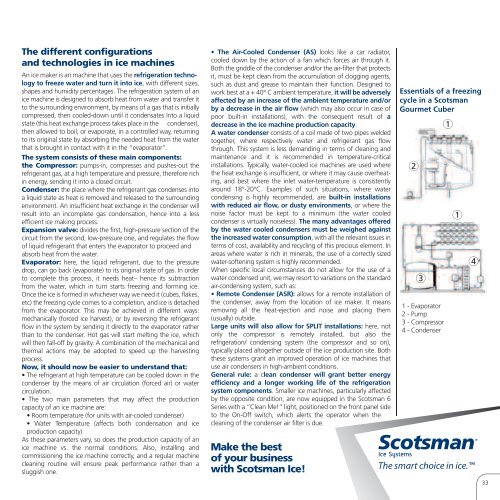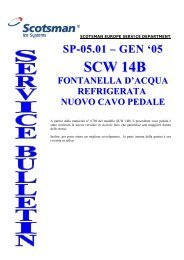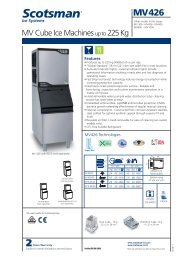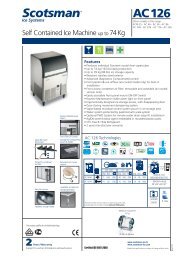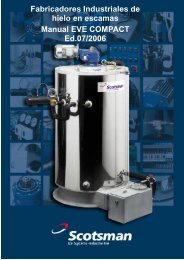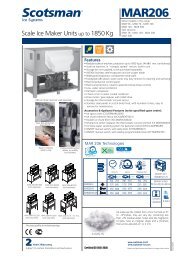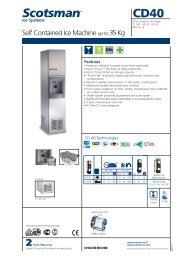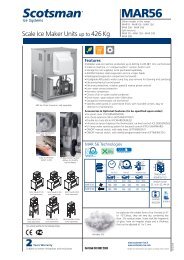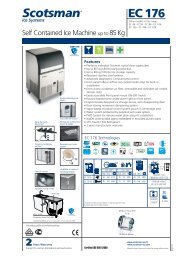You also want an ePaper? Increase the reach of your titles
YUMPU automatically turns print PDFs into web optimized ePapers that Google loves.
<strong>The</strong> different configurations<br />
and technologies <strong>in</strong> <strong>ice</strong> mach<strong>in</strong>es<br />
An <strong>ice</strong> maker is an mach<strong>in</strong>e that uses the refrigeration technology<br />
to freeze water and turn it <strong>in</strong>to <strong>ice</strong>, with different sizes,<br />
shapes and humidity percentages. <strong>The</strong> refrigeration system of an<br />
<strong>ice</strong> mach<strong>in</strong>e is designed to absorb heat from water and transfer it<br />
to the surround<strong>in</strong>g environment, by means of a gas that is <strong>in</strong>itially<br />
compressed, then cooled-down until it condensates Into a liquid<br />
state (this heat exchange process takes place <strong>in</strong> the condenser),<br />
then allowed to boil, or evaporate, <strong>in</strong> a controlled way, return<strong>in</strong>g<br />
to its orig<strong>in</strong>al state by absorb<strong>in</strong>g the needed heat from the water<br />
that is brought <strong>in</strong> contact with it <strong>in</strong> the “evaporator”.<br />
<strong>The</strong> system consists of these ma<strong>in</strong> components:<br />
the Compressor: pumps-<strong>in</strong>, compresses and pushes-out the<br />
refrigerant gas, at a high temperature and pressure, therefore rich<br />
<strong>in</strong> energy, send<strong>in</strong>g it <strong>in</strong>to a closed circuit.<br />
Condenser: the place where the refrigerant gas condenses <strong>in</strong>to<br />
a liquid state as heat is removed and released to the surround<strong>in</strong>g<br />
environment. An <strong>in</strong>sufficient heat exchange <strong>in</strong> the condenser will<br />
result <strong>in</strong>to an <strong>in</strong>complete gas condensation, hence <strong>in</strong>to a less<br />
efficient <strong>ice</strong> mak<strong>in</strong>g process.<br />
Expansion valve: divides the first, high-pressure section of the<br />
circuit from the second, low-pressure one, and regulates the flow<br />
of liquid refrigerant that enters the evaporator to proceed and<br />
absorb heat from the water.<br />
Evaporator: here, the liquid refrigerant, due to the pressure<br />
drop, can go back (evaporate) to its orig<strong>in</strong>al state of gas. In order<br />
to complete this process, it needs heat– hence its subtraction<br />
from the water, which <strong>in</strong> turn starts freez<strong>in</strong>g and form<strong>in</strong>g <strong>ice</strong>.<br />
Once the <strong>ice</strong> is formed <strong>in</strong> whichever way we need it (cubes, flakes,<br />
etc) the freez<strong>in</strong>g cycle comes to a completion, and <strong>ice</strong> is detached<br />
from the evaporator. This may be achieved <strong>in</strong> different ways:<br />
mechanically (forced <strong>ice</strong> harvest), or by revers<strong>in</strong>g the refrigerant<br />
flow <strong>in</strong> the system by send<strong>in</strong>g it directly to the evaporator rather<br />
than to the condenser. Hot gas will start melt<strong>in</strong>g the <strong>ice</strong>, which<br />
will then fall-off by gravity. A comb<strong>in</strong>ation of the mechanical and<br />
thermal actions may be adopted to speed up the harvest<strong>in</strong>g<br />
process.<br />
Now, it should now be easier to understand that:<br />
• <strong>The</strong> refrigerant at high temperature can be cooled down <strong>in</strong> the<br />
condenser by the means of air circulation (forced air) or water<br />
circulation.<br />
• <strong>The</strong> two ma<strong>in</strong> parameters that may affect the production<br />
capacity of an <strong>ice</strong> mach<strong>in</strong>e are:<br />
• Room temperature (for units with air-cooled condenser)<br />
• Water Temperature (affects both condensation and <strong>ice</strong><br />
production capacity)<br />
As these parameters vary, so does the production capacity of an<br />
<strong>ice</strong> mach<strong>in</strong>e vs. the normal conditions. Also, <strong>in</strong>stall<strong>in</strong>g and<br />
commission<strong>in</strong>g the <strong>ice</strong> mach<strong>in</strong>e correctly, and a regular mach<strong>in</strong>e<br />
clean<strong>in</strong>g rout<strong>in</strong>e will ensure peak performance rather than a<br />
sluggish one.<br />
• <strong>The</strong> Air-Cooled Condenser (AS) looks like a car radiator,<br />
cooled down by the action of a fan which forces air through it.<br />
Both the griddle of the condenser and/or the air-filter that protects<br />
it, must be kept clean from the accumulation of clogg<strong>in</strong>g agents,<br />
such as dust and grease to ma<strong>in</strong>ta<strong>in</strong> their function. Designed to<br />
work best at a + 40° C ambient temperature, it will be adversely<br />
affected by an <strong>in</strong>crease of the ambient temperature and/or<br />
by a decrease <strong>in</strong> the air flow (which may also occur <strong>in</strong> case of<br />
poor built-<strong>in</strong> <strong>in</strong>stallations), with the consequent result of a<br />
decrease <strong>in</strong> the <strong>ice</strong> mach<strong>in</strong>e production capacity.<br />
A water condenser consists of a coil made of two pipes welded<br />
together, where respectively water and refrigerant gas flow<br />
through. This system is less demand<strong>in</strong>g <strong>in</strong> terms of clean<strong>in</strong>g and<br />
ma<strong>in</strong>tenance and it is recommended <strong>in</strong> temperature-critical<br />
<strong>in</strong>stallations. Typically, water-cooled <strong>ice</strong> mach<strong>in</strong>es are used where<br />
the heat exchange is <strong>in</strong>sufficient, or where it may cause overheat<strong>in</strong>g,<br />
and best where the <strong>in</strong>let water-temperature is consistently<br />
around 18°-20°C. Examples of such situations, where water<br />
condens<strong>in</strong>g is highly recommended, are built-<strong>in</strong> <strong>in</strong>stallations<br />
with reduced air flow, or dusty environments, or where the<br />
noise factor must be kept to a m<strong>in</strong>imum (the water cooled<br />
condenser is virtually noiseless). <strong>The</strong> many advantages offered<br />
by the water cooled condensers must be weighed aga<strong>in</strong>st<br />
the <strong>in</strong>creased water consumption, with all the relevant issues <strong>in</strong><br />
terms of cost, availability and recycl<strong>in</strong>g of this precious element. In<br />
areas where water is rich <strong>in</strong> m<strong>in</strong>erals, the use of a correctly sized<br />
water-soften<strong>in</strong>g system is highly recommended.<br />
When specific local circumstances do not allow for the use of a<br />
water condensed unit, we may resort to variations on the standard<br />
air-condens<strong>in</strong>g system, such as:<br />
• Remote Condenser (ASR): allows for a remote <strong>in</strong>stallation of<br />
the condenser, away from the location of <strong>ice</strong> maker. It means<br />
remov<strong>in</strong>g all the heat-ejection and noise and plac<strong>in</strong>g them<br />
(usually) outside.<br />
Large units will also allow for SPLIT <strong>in</strong>stallations: here, not<br />
only the compressor is remotely <strong>in</strong>stalled, but also the<br />
refrigeration/ condens<strong>in</strong>g system (the compressor and so on),<br />
typically placed altogether outside of the <strong>ice</strong> production site. Both<br />
these systems grant an improved operation of <strong>ice</strong> mach<strong>in</strong>es that<br />
use air condensers <strong>in</strong> high-ambient conditions.<br />
General rule: a clean condenser will grant better energy<br />
efficiency and a longer work<strong>in</strong>g life of the refrigeration<br />
system components. Smaller <strong>ice</strong> mach<strong>in</strong>es, particularly affected<br />
by the opposite condition, are now equipped <strong>in</strong> the <strong>Scotsman</strong> 6<br />
Series with a “Clean Me!” light, positioned on the front panel side<br />
to the On-Off switch, which alerts the operator when the<br />
clean<strong>in</strong>g of the condenser air filter is due.<br />
Make the best<br />
of your bus<strong>in</strong>ess<br />
with <strong>Scotsman</strong> Ice!<br />
Essentials of a freez<strong>in</strong>g<br />
cycle <strong>in</strong> a <strong>Scotsman</strong><br />
Gourmet Cuber<br />
2<br />
3<br />
1 - Evaporator<br />
2 - Pump<br />
3 - Compressor<br />
4 - Condenser<br />
<strong>The</strong> <strong>smart</strong> <strong>cho<strong>ice</strong></strong> <strong>in</strong> <strong>ice</strong>.<br />
1<br />
1<br />
4<br />
33


